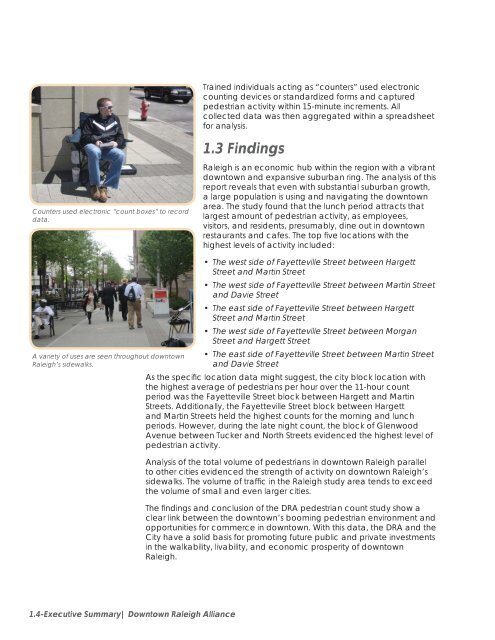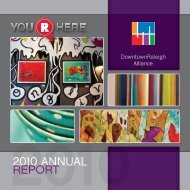Pedestrian Count Study - Downtown Raleigh Alliance
Pedestrian Count Study - Downtown Raleigh Alliance
Pedestrian Count Study - Downtown Raleigh Alliance
You also want an ePaper? Increase the reach of your titles
YUMPU automatically turns print PDFs into web optimized ePapers that Google loves.
Trained individuals acting as “counters” used electronic<br />
counting devices or standardized forms and captured<br />
pedestrian activity within 15-minute increments. All<br />
collected data was then aggregated within a spreadsheet<br />
for analysis.<br />
1.3 Findings<br />
<strong>Count</strong>ers used electronic “count boxes” to record<br />
data.<br />
<strong>Raleigh</strong> is an economic hub within the region with a vibrant<br />
downtown and expansive suburban ring. The analysis of this<br />
report reveals that even with substantial suburban growth,<br />
a large population is using and navigating the downtown<br />
area. The study found that the lunch period attracts that<br />
largest amount of pedestrian activity, as employees,<br />
visitors, and residents, presumably, dine out in downtown<br />
restaurants and cafes. The top fi ve locations with the<br />
highest levels of activity included:<br />
A variety of uses are seen throughout downtown<br />
<strong>Raleigh</strong>’s sidewalks.<br />
• The west side of Fayetteville Street between Hargett<br />
Street and Martin Street<br />
• The west side of Fayetteville Street between Martin Street<br />
and Davie Street<br />
• The east side of Fayetteville Street between Hargett<br />
Street and Martin Street<br />
• The west side of Fayetteville Street between Morgan<br />
Street and Hargett Street<br />
• The east side of Fayetteville Street between Martin Street<br />
and Davie Street<br />
As the specifi c location data might suggest, the city block location with<br />
the highest average of pedestrians per hour over the 11-hour count<br />
period was the Fayetteville Street block between Hargett and Martin<br />
Streets. Additionally, the Fayetteville Street block between Hargett<br />
and Martin Streets held the highest counts for the morning and lunch<br />
periods. However, during the late night count, the block of Glenwood<br />
Avenue between Tucker and North Streets evidenced the highest level of<br />
pedestrian activity.<br />
Analysis of the total volume of pedestrians in downtown <strong>Raleigh</strong> parallel<br />
to other cities evidenced the strength of activity on downtown <strong>Raleigh</strong>’s<br />
sidewalks. The volume of traffi c in the <strong>Raleigh</strong> study area tends to exceed<br />
the volume of small and even larger cities.<br />
The fi ndings and conclusion of the DRA pedestrian count study show a<br />
clear link between the downtown’s booming pedestrian environment and<br />
opportunities for commerce in downtown. With this data, the DRA and the<br />
City have a solid basis for promoting future public and private investments<br />
in the walkability, livability, and economic prosperity of downtown<br />
<strong>Raleigh</strong>.<br />
1.4-Executive Summary| <strong>Downtown</strong> <strong>Raleigh</strong> <strong>Alliance</strong>







